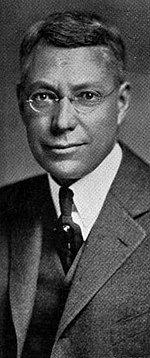|
Sherman R. Moulton
Sherman R. Moulton (June 10, 1876 – June 16, 1949) was a Vermont attorney and judge. He is most notable for his service as an associate justice of the Vermont Supreme Court (1926-1939) and as Chief Justice (1939-1949). Early lifeSherman Roberts Moulton was born in New York City on June 10, 1876, the son of Annie Jane Roberts and Clarence Freeman Moulton.[1] He was raised in Randolph, Vermont, and graduated from Randolph High School.[1] Moulton was an 1898 graduate of Dartmouth College, and in 1901 he received his LL.B. from Harvard Law School.[1] He completed his legal training with attorney Joseph D. Denison of Randolph, and attained admission to the bar in October 1901.[1] Start of careerMoulton was an attorney for the Rutland Railroad from 1902 to 1903, and then worked as an associate at the Townsend & Avery firm in New York City.[1] In 1910, Moulton was one of the founding partners of Cowles, Moulton, & Stearns, a law firm located in Burlington, Vermont.[1] He left the firm in 1912, and established a Burlington office in which he was the principal.[1] Moulton was active in politics as a Republican; he was a member of the Burlington Republican Committee from 1910 to 1912, and was chairman beginning in 1911.[1] From 1911 to 1913, and again from 1915 to 1916, he served as Burlington's grand juror, responsible for pursuing prosecutions in the city court.[1][2] Continued careerFrom 1915 to 1917, Moulton was executive clerk and legal advisor to Governor Charles W. Gates.[2] During World War I, Moulton served as a member of Vermont's Public Safety Committee, the body formed to coordinate the state government's wartime planning and actions.[2] In 1918, Moulton was elected to the Vermont Senate, and he served in January, 1919.[2] In addition, he served as reporter of decisions for the Vermont Supreme Court. Judicial careerIn February, 1919, Moulton was appointed as a judge of the Vermont Superior Court, succeeding Eleazer L. Waterman.[2][3] He served until 1926 and advanced through seniority to chief judge. In October 1926, he succeeded Fred M. Butler as an associate justice of the Vermont Supreme Court.[4] In July 1938, Moulton was appointed as chief justice of the state Supreme Court, succeeding George M. Powers.[5] He was succeeded as an associate justice by Olin M. Jeffords.[6] Moulton served as chief justice until retiring in February 1949.[7] He was succeeded as chief justice by associate justice John C. Sherburne.[8] Death and burialMoulton died in Burlington on June 16, 1949.[9] He was buried at Moulton Cemetery in Randolph.[10] HonorsMoulton received the honorary degree of LL.D. from Boston University in 1941, and an honorary D.C.L. from the University of Vermont in 1945.[11] FamilyIn 1906, Moulton married Stella Platt (1880-1966) of Burlington.[1][12] They were the parents of a son, Horace (1907-1991), who became a successful corporate attorney.[1][13] References
SourcesBooks
Newspapers
External links |
||||||||||||||||||||||||||||||||||||||||||||||||||||||||||||||||||
